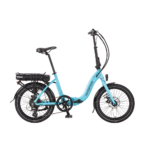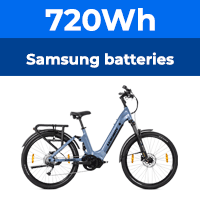Thanks for that, I like the rubber band idea !!If you enter "how to solder" into Google, you'll get many guides and videos on doing it. Keeping the connector body held still while soldering can be awkward if you know no ready way, but using a pair of pliers and an elastic band on the work surface is a simple way of doing that as shown here:

8 fun bikes, review of customer service
- Thread starter Alec67
- Start date
Electric soldering kit finally arrived and eventually managed to make a successful repair following everyone's instructions.
Reassembled everything, switched on, lights showing on throttle but when I press the throttle lever there is a clattering from the Tongxin motor and with the green light on the throttle flashing on and off it sounds like an intermittent and faulty connection.
I examined my soldered joint and that seems to be fine, I 'wiggled' every other joint on the wiring that was possible but still the same. I have this electrical tester but not sure if possible or how to use for a 36 volt battery.
Would appreciate further advice as to possible cause and whether the tester will help to track down what I am presuming is a bad connection.


Reassembled everything, switched on, lights showing on throttle but when I press the throttle lever there is a clattering from the Tongxin motor and with the green light on the throttle flashing on and off it sounds like an intermittent and faulty connection.
I examined my soldered joint and that seems to be fine, I 'wiggled' every other joint on the wiring that was possible but still the same. I have this electrical tester but not sure if possible or how to use for a 36 volt battery.
Would appreciate further advice as to possible cause and whether the tester will help to track down what I am presuming is a bad connection.


All that happened to cause this was the bike fell over? I'd be suspicious that other connections or components were damaged at that point or subsequently.
Put your meter on DC 200V range, put the black probe on the battery negative and with the positive work your way along the + supply line from the battery to the controller. Then, do the same in reverse for the negative line, ie, put the positive probe on the battery + and use the neg probe on the neg wire up to the controller. You might find a break in a connection. If it's a controller fault there's nothing much you can do, save replace it.
You can also test individual switches an components either by seeing what voltage is present/not present and whether they're conducting or not when they should, by using the resistance ranges on your meter, but someone who knows will be along shortly. I'm not familiar with the layout of your bike.
Put your meter on DC 200V range, put the black probe on the battery negative and with the positive work your way along the + supply line from the battery to the controller. Then, do the same in reverse for the negative line, ie, put the positive probe on the battery + and use the neg probe on the neg wire up to the controller. You might find a break in a connection. If it's a controller fault there's nothing much you can do, save replace it.
You can also test individual switches an components either by seeing what voltage is present/not present and whether they're conducting or not when they should, by using the resistance ranges on your meter, but someone who knows will be along shortly. I'm not familiar with the layout of your bike.
D
Deleted member 4366
Guest
It's still most likely a connection fault. You can get clattering with either a faulty phase-wire connection or a faulty hall sensor connection, so check them carefully. Be careful about testing with full power because if it's a faulty hall sensor, you can damage your controller because of the higher current through it.
Thanks for replies
Tested as you suggest using 200 ~ ( I hope that is 200 volts) and it showed 82.1 on both lines. Not sure how to use the 'resistance ranges' facility on the tester.Put your meter on DC 200V range, put the black probe on the battery negative and with the positive work your way along the + supply line from the battery to the controller. Then, do the same in reverse for the negative line, ie, put the positive probe on the battery + and use the neg probe on the neg wire up to the controller. You might find a break in a connection. If it's a controller fault there's nothing much you can do, save replace it.
You can also test individual switches an components either by seeing what voltage is present/not present and whether they're conducting or not when they should, by using the resistance ranges on your meter, but someone who knows will be along shortly. I'm not familiar with the layout of your bike.
How do I check a 'faulty phase-wire connection or a faulty hall sensor connection'.It's still most likely a connection fault. You can get clattering with either a faulty phase-wire connection or a faulty hall sensor connection, so check them carefully. Be careful about testing with full power because if it's a faulty hall sensor, you can damage your controller because of the higher current through it.
Hi I think for the non technical off you the following tester is properly the best idea
24V/36V/48V/60V E-bike Brushless Motor Controler Tester | eBay
Maybe a forum member has one he can loan out
or there maybe a uk supply please let us know if there is
Frank
24V/36V/48V/60V E-bike Brushless Motor Controler Tester | eBay
Maybe a forum member has one he can loan out
or there maybe a uk supply please let us know if there is
Frank
Thanks for that Geebee, I have now used the other setting and got 37.4 on both lines up to where it goes into the controller.No, you need to use the other 200 v setting the ~ is for AC.
Good luck.
@Alec67. It is of no use to own a multimeter unless you are willing to invest time in understanding and using it. There is no doubt plenty of info on the internet. Things can go wrong, and result in your meter smoking or catching fire, burned hands, or if you are very unlucky, exploding batteries.
1. At this stage do not attempt to use the current[amps] range of your meter on your bike. If you connect the meter on a current range directly across the battery or battery leads, several hundred amps will flow through your meter, burning it out.
2 Resistance [ohms] ranges. Never use these ranges on a circuit without first disconnecting the battery.
3 Be careful not to short circuit connections or wires together, especially when working on crowded areas such as the controller.
Learn the difference between voltage, current and resistance , and AC [alternating current] and DC [direct current]. A little study will pay great dividends. We are always here to help.
1. At this stage do not attempt to use the current[amps] range of your meter on your bike. If you connect the meter on a current range directly across the battery or battery leads, several hundred amps will flow through your meter, burning it out.
2 Resistance [ohms] ranges. Never use these ranges on a circuit without first disconnecting the battery.
3 Be careful not to short circuit connections or wires together, especially when working on crowded areas such as the controller.
Learn the difference between voltage, current and resistance , and AC [alternating current] and DC [direct current]. A little study will pay great dividends. We are always here to help.
Related Articles
-
 MTF Enterprises announces acquisition of EMU Electric Bikes
MTF Enterprises announces acquisition of EMU Electric Bikes- Started by: Pedelecs
-
 Wisper 806T folding bike wins Which? ‘Best Buy’
Wisper 806T folding bike wins Which? ‘Best Buy’- Started by: Pedelecs
-
 Sustrans calls for protected cycle lanes
Sustrans calls for protected cycle lanes- Started by: Pedelecs
-
 Amazon launch their first UK e-cargo micromobility hub
Amazon launch their first UK e-cargo micromobility hub- Started by: Pedelecs



